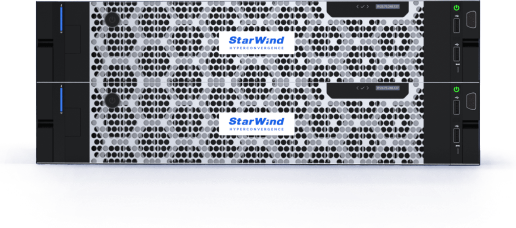A purpose-built backup appliance (PBBA) is becoming an increasingly common component of the backup infrastructure for modern businesses of all sizes. It significantly enhances the speed and reliability of backup and restore operations.
Many companies are incorporating purpose-built backup appliances as a key part of their data protection and business continuity strategies. Despite the growing adoption of cloud solutions, the importance of PBBAs remains strong, and the market is expected to continue thriving.
What is a Purpose-built backup appliance?
A purpose-built backup appliance is typically called a standalone disk-based storage device configured and optimized for storing backup data. Such solutions store data received from a backup application running externally or have a deeply integrated backup software component, a so-called “integrated backup appliance.”
The PBBA, as a primary backup storage device, usually incorporates such features as deduplication, compression, redundant hardware components, encryption, and automation of setup and maintenance.
The purpose-built backup appliance does not impact the main production hosts by running all backup-related workloads singularly. Because such solutions run separately, they do not take the resources of main hosts running primary workloads. Most of such solutions are easily integrable into existing infrastructure. Additionally, such solutions are packed with centralized UI to simplify the management and all related processes.
Why is PBBA used and important?
Purpose-built backup appliances are used for data protection and disaster recovery (DR). A solution solely focused on backup allows a business to better restore and recover after malware attacks, natural disasters, and hardware failures.
Backup and disaster recovery capabilities are critical for any organization. PBBAs can provide a way to flexibly and easily add high-reliability backups for any organization.
Additionally, with the purpose-built backup appliance, the company can receive the following benefits:
- Shrink the backup and restore windows. The PBBA is a disk-based storage device, so fast disks like SSD and NVMe can be used to build the solution, resulting in high storage performance and reducing the time needed to perform backups and restores.
- Better Storage efficiency. By utilizing the deduplication and compression capabilities of backup and storage components, PBAA optimizes data and reduces the space needed for backups.
- Utilizing Hybrid Cloud Storage. Companies can combine the on-site solution with cloud storage to have additional copies of the backup data in case of an accident with the on-prem backup repository.
- Hardened Security. Companies can secure their data from malware or other types of attacks by utilizing encryption or similar features.
- Disaster Recovery. For disaster recovery, companies can create a copy of the backup data and put it on another backup appliance in another location or vice versa.
The PBBA is more than just a storage repository. Such solutions provide a list of capabilities that increase data security and efficiency.
Also, PBBA is not the only option used. Nowadays, we often see PBBA used as one of the components of a more complex approach. We call it the 3-2-1 backup rule. The 3-2-1 Rule is a data protection strategy that recommends having three copies of your data, stored on two different types of media, with one copy kept off-site.
As a widely embraced data backup strategy, the 3-2-1 Rule prescribes:
- Maintain three copies of your data: This includes the original data and at least two copies.
- Use two different types of media for storage: Store your data on two distinct forms of media to enhance redundancy.
- Keep at least one copy off-site: To ensure data safety, have one backup copy stored in an off-site location, separate from your primary data and on-site backups.
This rule is a robust guideline for data protection, ensuring redundancy, resilience, and the ability to recover data even in the face of unexpected events or disasters.
However, the modern world brings new challenges, and strategies should evolve. Today we see different versions of the 3-2-1 backup rule evolution. The most common one being 3-2-1-1-0.
The 3-2-1-1-0 backup rule is a modernized approach to data protection, designed to add resilience and security in today’s complex digital landscape. Here’s what each part of the rule stands for:
- 3 Copies of Data: Always maintain three copies of your data—one primary and two backups.
- 2 Different Types of Media: Store your data on two different media types.
- 1 Off-Site Copy: Keep at least one backup copy off-site to protect your data from local disasters like fires, floods, or hardware failures.
- 1 Immutable or Air-Gapped Backup: Add an extra layer of protection by having one backup that is either immutable (cannot be altered or deleted) or air-gapped (disconnected from the network).
- 0 Errors (Verified Backups): Ensure that your backups are error-free by regularly verifying them.
Factors to Consider When Buying PBBA
When considering potential backup appliance vendors and PBBA options, certain fundamental requirements are essential for ensuring these systems operate efficiently. These include:
- Plug and Play. The backup appliance should be ready to use out of the box. It comes pre-configured with the minimum required to integrate it into existing infrastructure.
- Flexibility. A PBBA should be adjustable and adaptable to meet a business’s evolving needs and demands. A helpful solution can be used in various ways: as a single appliance or as a cluster member sharing its resources with other cluster members.
- Manageability. A backup appliance should provide centralized management and reporting through a user-friendly central console to save IT time and resources. Additionally, businesses should look for a solution that allows clients to deploy their software across multiple appliances to simplify operations.
- Additional features. A PBBA can accommodate new services as needed, making it an essential component of a growing organization’s storage needs. It allows for the management of features like archiving or snapshots from one central hub.
Purpose-built backup appliance key features
Backup appliance vendors typically highlight the following PBBA features:
- Effortless appliance setup and management: These systems typically feature interfaces that automate various aspects of installation and maintenance.
- Redundant hardware components, such as multiple power supplies and network interface cards (NICs). It allows solution to sustain hardware failure and not disrupt backup operations.
- Encryption of data at rest protects the data currently stored on the PBBA from being accessed in the event of a malware attack.
- It allows for deduplication of backup data at the source and in-line, eliminating redundant copies of stored information and reducing overall storage costs.
- Immutability: Protects data by rendering it untouchable and perpetual, regardless of the timeframe. A solution with such a feature ensures the information remains pristine, unaltered, and undeletable, upholding its original state.
Purpose-built backup appliance limitations
The primary limitation of using a PBBA is that it is dedicated solely to backup and recovery. The data is deduplicated (broken into fragments and distributed across multiple blocks) and stored in a proprietary format. Consequently, it cannot be used for other purposes like analytics.
Rehydrating data (reconstructing fragmented data blocks) can also extend restore times.
However, the PBBA industry addresses these limitations by incorporating flash storage and various architectural enhancements to accelerate data restores and enable secondary use cases for stored data.
What StarWind has to offer?
When it comes to data protection, StarWind provides versatile options, whether you’re starting from scratch or utilizing existing hardware.
The StarWind Backup Appliance serves as a ransomware-proof backup target, ensuring data safety with immutability. It offers lightning-fast backup and restore performance thanks to its all-NVMe storage, and reduces costs through deduplication and automatic offloading of cold backups to the cloud. It’s the Swiss Army Knife® of data protection, managing backups, cutting costs, and integrating seamlessly with Veeam right out of the box.
The StarWind Virtual Backup Appliance allows you to repurpose existing hardware into a robust backup infrastructure. It features the same software stack as the physical appliance, including immutability, deduplication, public cloud offloading, and AI-powered issue resolution. This solution is ideal for revitalizing old production clusters.
Conclusion
A purpose-built backup appliance (PBBA) is a disk-based solution specifically designed for backing up data from backup applications. Organizations typically deploy PBBAs in standalone configurations to enhance backup processes by reducing backup and recovery times across various operating systems and applications.
PBBAs have become essential for many organizations aiming to optimize their backup and restore operations. Despite their original design to address tape-related challenges, PBBAs remain relevant in hybrid-cloud environments, providing rapid on-premises data restoration and replication.


